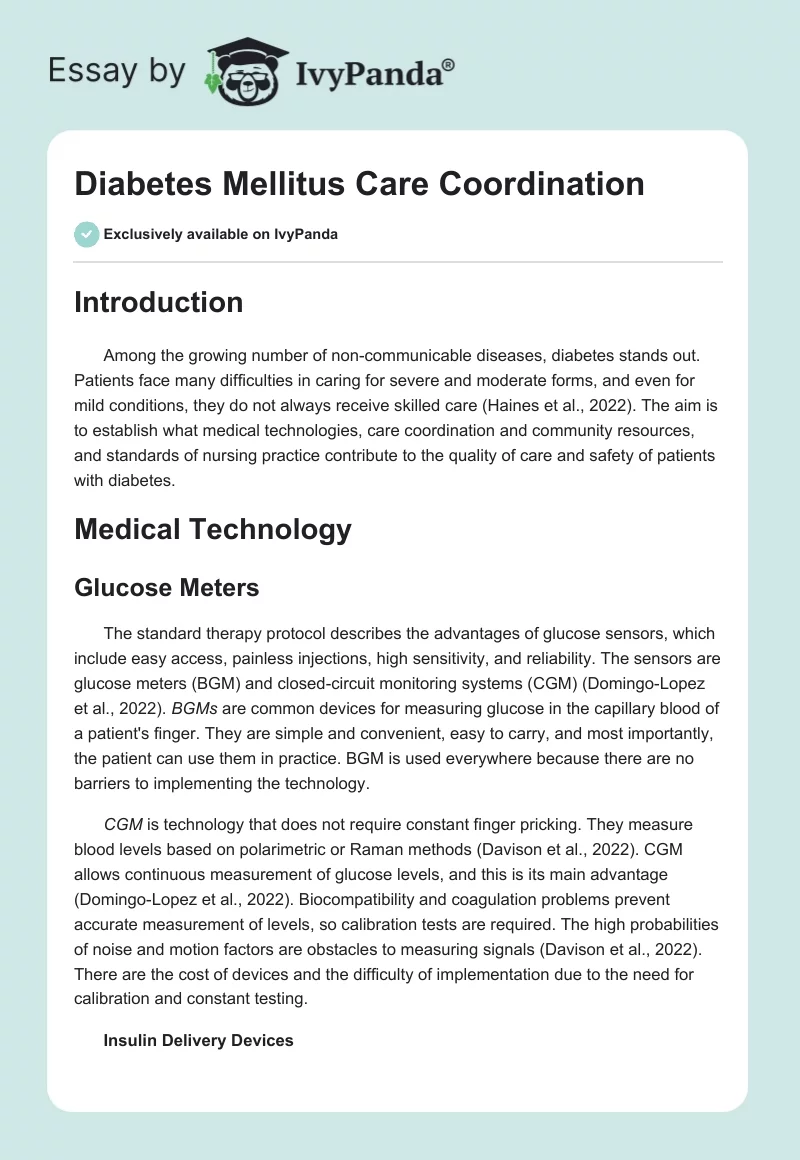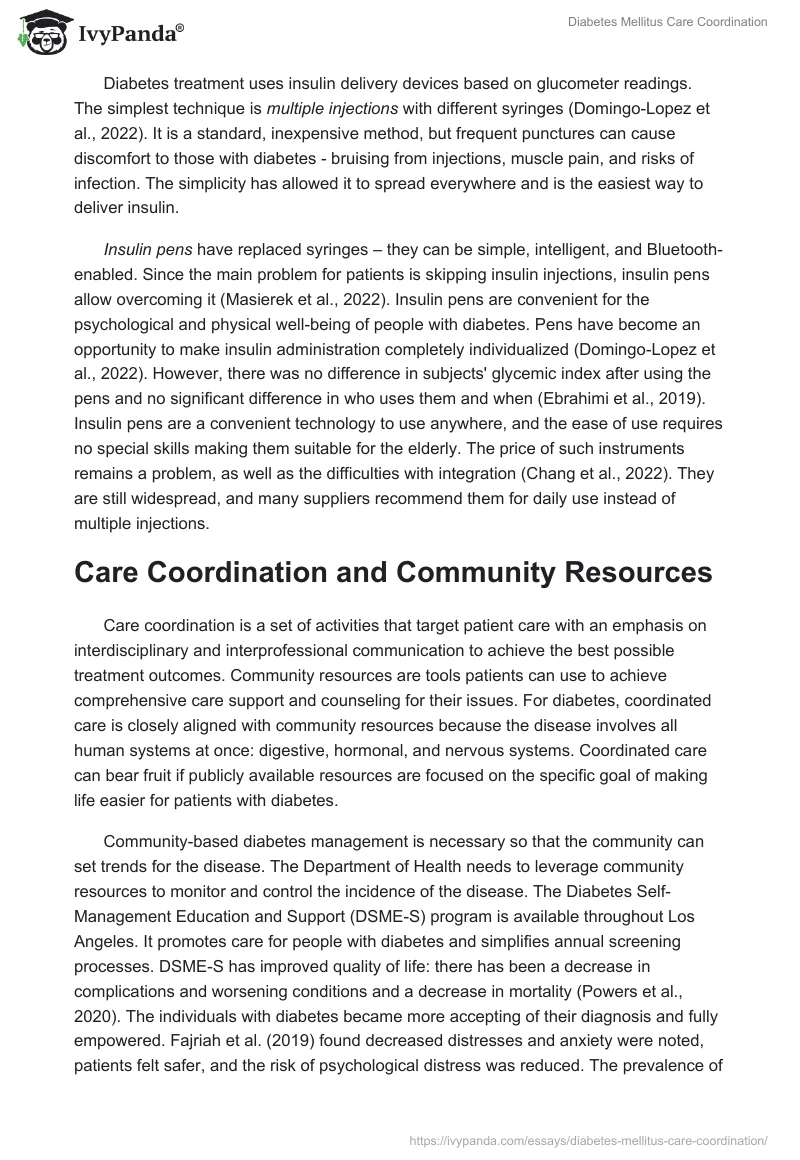Introduction
Among the growing number of non-communicable diseases, diabetes stands out. Patients face many difficulties in caring for severe and moderate forms, and even for mild conditions, they do not always receive skilled care (Haines et al., 2022). The aim is to establish what medical technologies, care coordination and community resources, and standards of nursing practice contribute to the quality of care and safety of patients with diabetes.
Medical Technology
Glucose Meters
The standard therapy protocol describes the advantages of glucose sensors, which include easy access, painless injections, high sensitivity, and reliability. The sensors are glucose meters (BGM) and closed-circuit monitoring systems (CGM) (Domingo-Lopez et al., 2022). BGMs are common devices for measuring glucose in the capillary blood of a patient’s finger. They are simple and convenient, easy to carry, and most importantly, the patient can use them in practice. BGM is used everywhere because there are no barriers to implementing the technology.
CGM is technology that does not require constant finger pricking. They measure blood levels based on polarimetric or Raman methods (Davison et al., 2022). CGM allows continuous measurement of glucose levels, and this is its main advantage (Domingo-Lopez et al., 2022). Biocompatibility and coagulation problems prevent accurate measurement of levels, so calibration tests are required. The high probabilities of noise and motion factors are obstacles to measuring signals (Davison et al., 2022). There are the cost of devices and the difficulty of implementation due to the need for calibration and constant testing.
Insulin Delivery Devices
Diabetes treatment uses insulin delivery devices based on glucometer readings. The simplest technique is multiple injections with different syringes (Domingo-Lopez et al., 2022). It is a standard, inexpensive method, but frequent punctures can cause discomfort to those with diabetes – bruising from injections, muscle pain, and risks of infection. The simplicity has allowed it to spread everywhere and is the easiest way to deliver insulin.
Insulin pens have replaced syringes – they can be simple, intelligent, and Bluetooth-enabled. Since the main problem for patients is skipping insulin injections, insulin pens allow overcoming it (Masierek et al., 2022). Insulin pens are convenient for the psychological and physical well-being of people with diabetes. Pens have become an opportunity to make insulin administration completely individualized (Domingo-Lopez et al., 2022). However, there was no difference in subjects’ glycemic index after using the pens and no significant difference in who uses them and when (Ebrahimi et al., 2019). Insulin pens are a convenient technology to use anywhere, and the ease of use requires no special skills making them suitable for the elderly. The price of such instruments remains a problem, as well as the difficulties with integration (Chang et al., 2022). They are still widespread, and many suppliers recommend them for daily use instead of multiple injections.
Care Coordination and Community Resources
Care coordination is a set of activities that target patient care with an emphasis on interdisciplinary and interprofessional communication to achieve the best possible treatment outcomes. Community resources are tools patients can use to achieve comprehensive care support and counseling for their issues. For diabetes, coordinated care is closely aligned with community resources because the disease involves all human systems at once: digestive, hormonal, and nervous systems. Coordinated care can bear fruit if publicly available resources are focused on the specific goal of making life easier for patients with diabetes.
Community-based diabetes management is necessary so that the community can set trends for the disease. The Department of Health needs to leverage community resources to monitor and control the incidence of the disease. The Diabetes Self-Management Education and Support (DSME-S) program is available throughout Los Angeles. It promotes care for people with diabetes and simplifies annual screening processes. DSME-S has improved quality of life: there has been a decrease in complications and worsening conditions and a decrease in mortality (Powers et al., 2020). The individuals with diabetes became more accepting of their diagnosis and fully empowered. Fajriah et al. (2019) found decreased distresses and anxiety were noted, patients felt safer, and the risk of psychological distress was reduced. The prevalence of DSME-S in practice is not as high: only 10-15% of the total number of subjects (Powers et al., 2020). Current community resources are insufficient to cover the entire population with diabetes.
Care coordination for patients with diabetes includes targeting action to lower glucose levels to normal. The level of control varies considerably across communities: Rawlins et al. report that among African American and Hispanic populations, there is a significantly lower level of control (Rawlins et al., 2017). However, using community resources – in the Rawlins et al. study bilingual educators – allows for positive changes, including reduced economic costs. Care coordination achieves statistically significant reductions in glycated hemoglobin levels and improves diabetes control (McLendon et al., 2019). In doing so, inpatient care costs are almost halved, and providers are better able to reallocate resources. In Horikawa et al. study, regional coordination achieved regular physician visits (Horikawa et al., 2018). However, no differences were found in glycated hemoglobin levels.
Standards of Nursing Practice
The DSME-S has been in effect for a long time and defines standards of care: the primary focus is on how to motivate patients to check their glycemic index and monitor their condition. Since 2017, changes have been made to the DSME-S standards: quality coordinators determine the effectiveness of staff actions, assess the impact on morbidity, and refer staff for retraining to work with diabetes ((“The ADA’s 2022 standards of medical care in diabetes update “, 2022). These actions have improved patient safety from additional risks and complications. DSME-S practices have reduced provider costs for inpatient care and have simplified physician-patient information exchange processes (Fajriah et al., 2019). The staff became better trained and had a better idea of regulating their actions.
The state programs in Los Angeles aim to develop coordinated care for patients with diabetes. Registered nurses receive hands-on education while providing care and refer to their wards for further screening to rule out risks (“The ADA’s 2022 standards of medical care in diabetes update “, 2022). Expanded standards for diabetes care have been in place that has allowed nurses to make care systematic and include monitoring of comorbidities as part of their responsibilities (“Diabetes standards of care 2022”, 2022). They have led to a change in focus from routine care to complete diabetes prevention. It changed the approach to care and required nurses to collaborate and communicate interprofessional ((“Diabetes standards of care 2022”, 2022). Nurses organize care according to broad ethical principles, coordinating with multiple authorities.
Regarding ethics, nurses must pay attention to how patient education and motivation are conducted. Cultural and ethnic differences must be considered, ages must be respected, and the format must be coordinated comfortably for the patient. Nursing ethics determine how care will be organized: what type of technology is comfortable for a teenager and what type is comfortable for an adult. Nurses can recommend particular care resources depending on the individual’s living arrangements. Standards will make care systematic: nurses will manage care based on available evidence and form a patient-focused worldview.
Conclusion
Diabetes is a severe disease to which all care components must be applied. It is necessary to consider the individual’s characteristics to determine which glucose meters and insulin delivery devices are best suited. Coordinated care is imperative to improve wellness, and motivation to participate in government programs will reduce morbidity. Nurses must base their work on ethical standards and consider the cultural aspect of working with diabetic patients.
References
Chang, T., Li, H., Zhang, N., Jiang, X., Yu, X., Yang, Q., Jin, Z., Meng, H., & Chang, L. (2022). Highly integrated watch for noninvasive continual glucose monitoring. Microsystems & Nanoengineering, 8(25).
Davison, N. B., Gaffney, C. J., Kerns, J. G., & Zhuang, Q. D. (2022). Recent progress and perspectives on non-invasive glucose sensors.Diabetology, 3(1),56-71.
Diabetes standards of care 2022. (2022). Guideline Central.
Domingo-Lopez, D. A., Lattanzi, G., H J Schreiber, L., Wallace, E. J., Wylie, R., O’Sullivan, J., Dolan, E. B., & Duffy, G. P. (2022). Medical devices, smart drug delivery, wearables and technology for the treatment of Diabetes Mellitus.Advanced drug delivery reviews, 185.
Ebrahimi, H., Pishgar, F., Yoosefi, M., Moradi, S., Rezaei, N., Djalalinia, S., Modirian, M., Peykari, N., Naderimagham, S., Haghshenas, R., Rahimi, S., Jamshidi, H., Esteghamati, A., Larijani, B., & Farzadfar, F. (2019). Insulin pen use and diabetes treatment goals: A study from Iran STEPS 2016 survey.PloS One, 14(8).
Fajriah, N., Firmanti, T. A., Mufidah, A., & Septiana, N. T. (2019). A diabetes self-management education/support (DSME/S) program in reference to the biological, psychological and social aspects of a patient with type 2 diabetes mellitus: A systematic review. Jurnal NERS, 14(3). Web.
Haines, M. S., Leong, A., Porneala, B. C., Meigs, J. B., & Millner, K. K. (2022). Association between muscle mass and diabetes prevalence independent of body fat distribution in adults under 50 years old.Nutrition & Diabetes, 12(29).
Horikawa, Y., Suzuki, A., Hashimoto, K. I., Enya, M., Nishida, S., Kobayashi, R., Ohashi, T., Yamazaki, F., Totani, R., Kobayashi, H., Yamamoto, M., Itoh, Y., & Takeda, J. (2018). Evaluation of the diabetes regional coordination path using the diabetes coordination notebook in community-based diabetes care.Diabetology International, 10(3), 188–197.
Masierek, M., Nabrdalik, K., Janota, O., Kwiendacz, H., Macherski, M., & Gumprecht, J. (2022). The review of insulin pens-past, present, and look to the future. Frontiers in Endocrinology, 13.
McLendon, S. F., Wood, F. G., & Stanley, N. (2019). Enhancing diabetes care through care coordination, telemedicine, and education: Evaluation of a rural pilot program.Public health nursing (Boston, Mass.), 36(3), 310–320.
Powers, M. A., Bardsley, J. K., Cypress, M., Funnell, M. M., Harms, D., Hess-Fischl, A., Hooks, B., Isaacs, D., Mandel, E., D., Maryniuk, M. D., Norton, A., Rinker, J., Siminerio, L. M., & Uelmen, S. (2020). Diabetes self-management education and support in adults with type 2 diabetes: A consensus report of the American diabetes association, the association of diabetes care & education specialists, the academy of nutrition and dietetics, the American academy of family physicians, the American academy of pas, the American association of nurse practitioners, and the American pharmacists association. Diabetes Care, 43(7), 1636–1649.
Rawlins, W. S., Toscano-Garand, M. A., & Graham, G. (2017). Diabetes management with a care coordinator improves glucose control in African Americans and Hispanics. Journal of education and health promotion, 6(22).
The ADA’s 2022 standards of medical care in diabetes update. (2022). National Institute of Diabetes and Digestive Kidney Diseases.


